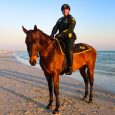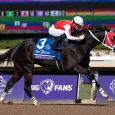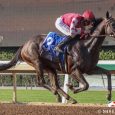The 2018 Churchill Downs Spring/Summer Meet begins on Saturday, April 28. What follows after opening night is one of the best weeks of racing of the year — Tuesday through Saturday of Kentucky Derby week at Churchill Downs. After that, the meet continues through the last day of June as one of the best early summer race meets in the country.
The centerpiece of the Churchill Spring/Summer Meet, of course, will be the 144th running of the Kentucky Derby on Saturday, May 5. The 2018 edition of the Run for the Roses is shaping to feature one of the strongest fields in years. The early favorite, undefeated Santa Anita Derby-winner Justify, is fast, but he has only three career races of experience and will need to defeat the very talented winners of the Arkansas Derby (Magnum Moon), Florida Derby (Audible), and UAE Derby (Mendelssohn), as well as the winners of the Wood Memorial (Vino Rosso) and the Louisiana Derby (Noble Indy), not to mention the winner of the Blue Grass, the 2-year-old champion Good Magic. Bolt d’Oro is no slouch, either. Handicapping the 2018 Kentucky Derby is going to be a challenge, that much is certain.
Derby Day, as well as Oaks Day on May 4, are always two of the best days of racing of the year. The Derby headlines a whole day of tremendous racing on both turf and dirt and is only one of seven graded stakes races on the May 5 full card. Here are a few tips to help you win opening week, on Derby Day, and beyond at Churchill Downs.
The three-week boutique Keeneland Spring meet comes and goes too quickly, but the meet will still provide a bounty of valuable information for handicappers that are anxiously awaiting Chruchill’s opening. Scan the past performances closely of the horses coming from Keeneland, they should provide clues as to which horses will improve based on the move to Churchill, and which might decline. Handicappers who understand the differences between Churchill and Keeneland will have the best chances to win consistently at Churchill Downs.
Day-to-day biases are much more common on the Churchill Downs dirt track than at Keeneland, so you will always want to pay closer attention to how the track is playing at any given moment in terms of post position or running style biases. In particular, pay close attention to how the rail plays in dirt races, because it has had a history of playing dead from time to time in Churchill Downs meets the past several years.
Churchill Downs Track Logistics
Both of Churchill Downs’ racing surfaces, the main track and the turf course, are rather unique surfaces that each have their own respective quirks that are important for handicappers to understand.
First, the Churchill Downs dirt course is often regarded as a very “cuppy” surface, meaning the track does not retain enough moisture in it to hold the sand together. This causes the track to break away from under horse’s feet resulting in footing that some horses love and others hate. This factor makes Churchill Downs one of the tracks where the horses-for-the-course angle means the most.
Second, the Churchill Downs turf course is also sand-based, making its composition very different from most other turf courses with the exceptions of Keeneland and Fair Grounds. Chances are, if a horse has recently run well on the turf at either Keeneland or Fair Grounds, that horse’s form is much more reliable at Churchill than turf horses shipping from other places, including Gulfstream Park. The Churchill turf, just like the dirt, is another place where you’ll want to heavily weight a horse’s past performances specifically on the home track’s oval.
Churchill Downs dirt mile races are run around one turn, and play more like sprints than routes. Unless a horse is already a proven one-turn mile performer, horses stretching from seven furlongs at Keeneland will do better in those races than horses trying to cut back from Keeneland routes (including one mile, which is a relatively new distance at Keeneland).
Finally, due to the cuppiness of Churchill’s dirt surface, the track is more likely to be faster and more conducive to speed in the summer when temperatures and humidity are higher. Early in the spring meet, including opening week, the track is likely to play slower when the weather is cool.
Angles for Chruchill Runners Coming from Gulfstream and Keeneland
Many of the horses running at Churchill will have made their last starts at either Gulfstream or Keeneland. One thing handicappers should always do when evaluating a horse’s chances is to win at Churchill Downs early in the meet is to pay special attention to the post positions that a horse drew in its recent races at either Keeneland or Gulfstream.
At Gulfstream, horses that drew outside posts in two-turn dirt races (1 1/16 miles to 1 1/8 miles) were at a disadvantage. Therefore, if you see a Churchill starter exiting a bad effort in one of those kinds of races at Gulfstream, you should remember to give that horse a partial excuse for the loss if it broke from wider than post six at 1 1/16-miles or 1 1/8-miles.
In turf sprints, Gulfstream’s five-furlong turf races enormously favor horses with early speed. It is difficult to rally and win those races at Gulfstream, but Churchill’s short turf races are much kinder to horses coming from off the pace. Keep this in mind, because early speed turf sprinters from Gulfstream that did well might not be as good as they look, while late-runners from those races who lost will not be nearly as bad as they look on paper.
As for the horses coming to Churchill from Keeneland, keep in mind that the inside six post positions (posts 1-6) are good in Keeneland sprints. If you see a horse coming out of a big Keeneland sprint effort from an outside post, you might want to upgrade the horse slightly at Churchill based on the fact it may have been at a post disadvantage at Keeneland.
Churchill Downs Turf Races
As far as biases go, Churchill Downs’ turf course is generally fair to horses breaking from all post positions no further out than post 8. Posts further outside than post 8 are at a bit of a disadvantage. The main turf distance that is affected by post positions is a flat mile, where the win percentages for outside posts drop to an extremely poor average of 3-4% winners. Therefore, generally speaking, posts outside number 8 are not great, and can be downright disastrous in turf races run at one mile. Take note also, that at a mile, middle posts 4-7 have, in the past, had an average win rate of nearly 20% making them clearly the best at that distance.
Beyond looking at post positions, the main thing you’ll want to take into account on the Churchill Downs lawn is a horse’s running style. Churchill’s turf course favors mid-pack pace-pressers and stalkers strongly over all other running styles. Early leaders generally have a difficult time going wire-to-wire on this turf course, and the deepest of closers have a tough time getting up in time to win.
This analysis is especially true in one-mile turf races, where early speed horses win less than nine percent of the time, and closers coming from further than 10 lengths behind win even less. The ideal winning profile in Churchill turf routes is a stalker that runs about four lengths off the pace at the first call (half-mile), and 2 1/2 lengths behind at the second call (6F mark).
The Churchill Downs Spring/Summer meet is always one of the best race meets at this time of year, and it all gets off to a great start on Kentucky Derby week. Stay on top of the winning trends, improve your winning percentage, and enjoy Derby week and the rest of the season at Churchill Downs.



